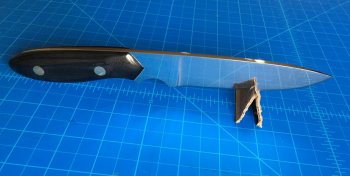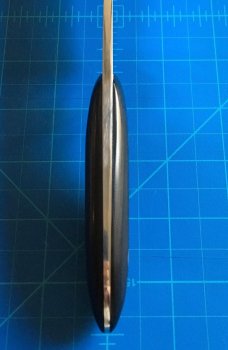OK here is my second knife.
I saw the design in Murray Carter's book (101 Knife Designs: Practical Knives for Daily Use), Carter seems have an appreciation for Kitchen cutlery and neck knifes. I had never really considered a neck knife as a particularly low key EDC, but his designs got me curious and I made this one to see what it would actually feel like to hold and use.
So:
CPM 154 steel
0.16 inch at its thickest
Tapered tang to reduce weight, plus it just looks cool.
I did not taper the whole blade much, but upon reflection I probably should have...
tried to do a mostly flat grind since the stock was so thick I figured I would get a better slicer while still being fairly strong.
black G10 for the scales

Things to learn and practice more.
How to make cleaner and more accurate plunge cuts. (They are not as even or straight as I would like)
Stop sooner on the course grit.
Take more time on each following grit to remove the previous scratches (There are some scratches that I did not get out and they show up real well in the polish).
need a better grinder! going to pull the trigger on ordering one before too long.
This knife is really too long for a neck knife. I should have made the blade around 3.5 inches for that.
The handle is definitely different, though fairly comfortable for light daily tasks. At the same time, if I wanted to hack at something I would want a different handle shape. A major plus to the handle design is that it is thin enough to be surprisingly inconspicuous and with little smaller version could probably be worn under a shirt as a neck knife and not be noticed too much.
As for performance, the knife really dose slice well and seems to hold an edge about as well as I would expect with this steel.

I saw the design in Murray Carter's book (101 Knife Designs: Practical Knives for Daily Use), Carter seems have an appreciation for Kitchen cutlery and neck knifes. I had never really considered a neck knife as a particularly low key EDC, but his designs got me curious and I made this one to see what it would actually feel like to hold and use.
So:
CPM 154 steel
0.16 inch at its thickest
Tapered tang to reduce weight, plus it just looks cool.
I did not taper the whole blade much, but upon reflection I probably should have...
tried to do a mostly flat grind since the stock was so thick I figured I would get a better slicer while still being fairly strong.
black G10 for the scales

Things to learn and practice more.
How to make cleaner and more accurate plunge cuts. (They are not as even or straight as I would like)
Stop sooner on the course grit.
Take more time on each following grit to remove the previous scratches (There are some scratches that I did not get out and they show up real well in the polish).
need a better grinder! going to pull the trigger on ordering one before too long.
This knife is really too long for a neck knife. I should have made the blade around 3.5 inches for that.
The handle is definitely different, though fairly comfortable for light daily tasks. At the same time, if I wanted to hack at something I would want a different handle shape. A major plus to the handle design is that it is thin enough to be surprisingly inconspicuous and with little smaller version could probably be worn under a shirt as a neck knife and not be noticed too much.
As for performance, the knife really dose slice well and seems to hold an edge about as well as I would expect with this steel.

Last edited:
